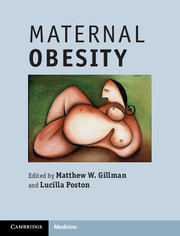Book contents
- Frontmatter
- Contents
- Contributors
- Preface
- Section 1 Trends and determinants of obesity in women of reproductive age
- Section 2 Pregnancy outcome
- 4 Maternal outcomes in obese pregnancies
- 5 Potential mechanisms contributing to gestational diabetes and pre-eclampsia in the obese woman
- 6 Fetal and infant outcomes in obese pregnant women
- 7 Obesity in pregnancy and mental health
- Section 3 Long-term consequences
- Section 4 Interventions
- Section 5 Management and policy
- Index
- Plate Section
- References
6 - Fetal and infant outcomes in obese pregnant women
from Section 2 - Pregnancy outcome
Published online by Cambridge University Press: 05 August 2012
- Frontmatter
- Contents
- Contributors
- Preface
- Section 1 Trends and determinants of obesity in women of reproductive age
- Section 2 Pregnancy outcome
- 4 Maternal outcomes in obese pregnancies
- 5 Potential mechanisms contributing to gestational diabetes and pre-eclampsia in the obese woman
- 6 Fetal and infant outcomes in obese pregnant women
- 7 Obesity in pregnancy and mental health
- Section 3 Long-term consequences
- Section 4 Interventions
- Section 5 Management and policy
- Index
- Plate Section
- References
Summary
Introduction
Fetal loss, stillbirth, infant death, and major structural congenital anomalyare among the most serious adverse outcomes that have been associated withmaternal obesity. This chapter summarizes the available epidemiologicalevidence, and discusses potential explanations and public healthimplications.
Maternal obesity and the risk of fetaland infant death
Fetal death and maternal obesity
Fetal death is the delivery of a fetus or infant that shows no signs of life.Fetal deaths are categorized as stillbirths or miscarriages on the basis ofgestational age at delivery. A stillbirth is the delivery of a baby at agestational age beyond the accepted threshold for viability that shows nosigns of life, and a miscarriage is a fetal loss at an earlier gestationalage. h e gestational age threshold dei ning stillbirth varies betweencountries, from 20 weeks in the United States [1], 24 weeks in the UK [2],and 28 weeks in other parts of Europe [3].
Around 1 in 200 births in developed countries ends in a stillbirth [4, 5],with limited evidence of improvement in recent years [1, 2]. Known maternalrisk factors for stillbirth include advanced age, nulliparity, ethnicbackground, maternal diabetes, hypertension, obesity, and smoking [ 6– 8]. he majority of stillbirths, around 85%, occur before the onset of labor(antepartum stillbirths) and the remainder occur during labor (intrapartumstillbirths) [2]. In epidemiological studies, a high proportion ofstillbirths, 10% to 70% depending on cause of death classii cation, aredescribed as “unexplained,” with no apparent underlying cause [5, 9]. Whileclinically many stillbirths occur unexpectedly in apparently uncomplicatedpregnancies, if exhaustive post-mortem investigations are undertaken, anunderlying cause can be identified in most cases [5]. However, in routineclinical practice, permission for autopsy is frequently either denied or notsought. The most frequent disorders include placental pathology, infection,umbilical cord abnormalities, congenital anomalies, and maternal medicaldisorders including diabetes and hypertension [9].
Information
- Type
- Chapter
- Information
- Maternal Obesity , pp. 56 - 69Publisher: Cambridge University PressPrint publication year: 2012
